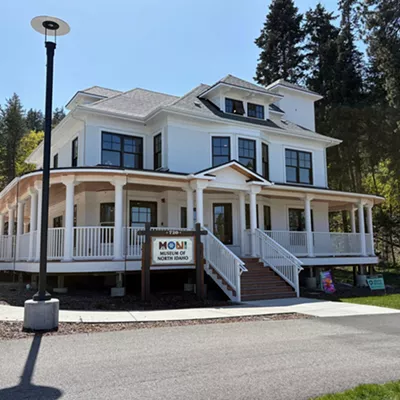When artists start to talk about art, the conversation frequently turns away from aesthetic concerns and so-and-so's current work, focusing instead on the things that artists want. Gallery shows, theater productions, art supplies, affordable concert venues, a more connected artistic community and film screenings are often the things that find their way onto artists' and art lovers' wish-lists.
The Inland Northwest's arts community has long struggled with these concerns, primarily because they have a certain amount of legitimacy behind them. It is impossible, after all, to view the work of a local filmmaker like Justin Whiteman -- whose remarkable feature-length satire of Spokane, Newtown, remains unseen in his hometown -- unless some theater owner or festival director decides to screen it. And a painter whose works are closed away in a studio will forever be limited to the reactions of friends and family until a gallery mounts an exhibition.
But during the past decade, the Inland Northwest has made major efforts to overcome these obstacles. Responding to an article in the newspaper that said Spokane needed a committed, contemporary gallery, Lorinda Knight started one of downtown's most provocative and engaging outlets for the arts. Kendall Feeney began the contemporary chamber music ensemble Zephyr 12 years ago and has consistently given unfamiliar composers and performers opportunities to connect with audiences. Even the disappearance of the Magic Lantern cinema hardly spelled the end of alternative movies, as a number of small festivals have joined the Panida, the Met and even the Shop in presenting classic and art films.
And a quick glance at downtown's ongoing revitalization makes the role of the arts clear. A restored Met theater, a newly designated Fox, several galleries, a professional theater company, two regular comedy troupes and the Opera House all join the public art in Riverfront Park, some area-wide film and literary festivals and the Arena and the Civic Theatre across the river to form a boldly defined nexus for the arts in the middle of Spokane. It raises the question of whether there would have even been a downtown to revive had the arts not taken up residence there first.
Regardless of these achievements, however, there's still work to be done. Someone once said, "There is no such thing as an arts emergency." The absurdity of this statement is immediately apparent when one considers that, even though it is not a biological necessity for life, mankind has given resources, comfort and time for the arts since some of the earliest signs of civilization. The arts have been inextricably linked to religion, politics and economics throughout history. It's hard to know what the Taliban's destruction of the two Bamiyan Buddhas or the Nazis' theft of European art treasures constitute, if not, in part, an "arts emergency."
Given the intrinsic role that the arts play in the re-emerging life of downtown, and the historic role the arts have played in all socially and financially thriving cultures, art in this economically and socially growing region is vital. The willful ignorance of a good artist, the closing-off of the community to the type of cultural discourse provoked by a socially challenging work and the loss of talented individuals to other cities easily constitute a local "art emergency."
That Spokane has taken steps, however, to foster and promote the region's arts and artists in the face of these problems is a sign that the arts face an even better future in Spokane than they do at present. (And if this year's Fall Arts Preview is any indication, the present situation is pretty good.) What may have been a large "emergency" in the past has been greatly reduced in size. Nevertheless, there are still a few glaring holes left to be plugged in Spokane's art scene.
Most notably, Spokane lacks a dedicated venue for live jazz performance. With nationally recognized musicians living and working in the region, and regional students actively pursuing a dedicated jazz education, a local example of the quintessential late-night club with an eclectic rotating performance lineup seems to be needed. No doubt a venue of this sort will face many of the same challenges that music clubs currently face. But if this community can actively request and create a space for alternative rock and pop music, it might find the same efforts would yield a jazz club as well.
Aside from bricks-and-mortar obstacles, Spokane may also find itself short of funds for the arts in the near future. Local colleges and businesses have underwritten many of the region's most provocative cultural events in the past. Recently Eastern Washington University has withdrawn funding for the contemporary music ensemble Zephyr and the Spokane String Quartet. Long-time art supporter Metropolitan Mortgage has begun diversifying its charitable giving, and the Wasmer Foundation, long a driving force in the arts community, is now under the umbrella direction of the larger Foundation Northwest. Without some new, dedicated supporters stepping clearly to the fore, Spokane's art scene will be facing a poorer future.
But perhaps the most elusive need in Spokane's artistic future lies in the realm of advocacy and criticism. As the arts continue to grow in the role that they play in the region's development, the need for incisive, active discussion becomes even more acute. Long given to the local media, the role of arts criticism in Spokane has over time turned into arts boosterism. While there is nothing wrong with encouraging the arts, especially when the community needs to see the arts grow and succeed, there seems to currently be less of a need for mollycoddling and more of a need for serious discussion. Theater, music, film and art reviews that offer hollow platitudes or vacant exposition to Inland Northwest audiences may boost attendance at certain events, but they offer nothing of use for the artists themselves. Audiences shouldn't leave theaters, galleries and concert halls while mumbling "Wasn't that nice?" Instead, critics and curators should initiate serious discussions, so that people will ask, "What did you think of that?"
But it would be wrong to assume that everything that Spokane needs to maintain a thriving art scene lies in the hands of entrepreneurs, critics and financial donors. In much the same way that the construction of a church does not give rise to a religion, even the most complete, well-funded artistic community would not necessarily give rise to good art.
Good art -- different from art that one merely likes or dislikes -- is something that can be found at any level of existence, with varying degrees of support. For every Shakespeare and Moliere who were in the economic and social good graces of a monarch, there were the Kafkas, Dvoraks and Basquiats who, at least initially, created their art without any significant financial or cultural help. They were the artists who, as the great Canadian author Robertson Davies said, needed to create their work or go mad -- or possibly die. They had to make art, and they did make art, regardless of whether there was a strong infrastructure to support them or even an audience to appreciate them.
Spokane, with its fragile downtown and uncertain economy, needs to remember that good art is not contingent upon such factors. A theater production can make an enormous difference to a troupe of actors and a playwright, and a good gallery show can turn a visual artist's career around; but art itself depends solely on the artist.
Theater in the region is a good example. In the Inland Northwest, there are plenty of theaters that are regularly accessible to imaginative directors and actors. And yet local audiences see a surprisingly small number of productions that challenge them with an abstract concept or experimental presentation. The obstacles for this type of theatrical adventure are not necessarily cost-based: one of America's most successful avant-garde stage directors, Robert Wilson, is famous for his minimal settings and effects. And audiences in Spokane will show up and support challenging work that has merit: Civic Theatre's A Child's Christmas in Wales and Interplayers occasionally angular Wings are still discussed as remarkable theater. Yet for every Macbeth that tries to break new ground -- success or failure -- there seem to be a dozen by-the-book revivals of Oklahoma.
The situation is hardly different in the other arts. Two years ago, Dada Zephyr, a remarkably absurd and difficult program of music, drew a large crowd to the Met. People talked excitedly in the lobby at intermission and left enthused, confused or delighted at the end. But they came and they considered. Several years ago, when Spokane Falls Community College brought the work of a number of cutting-edge Los Angeles artists to town, audiences were challenged but still supportive. And a few years earlier, Creative Arts Alliance brought a troupe of performance artists from around the world to the region. Despite the fact -- or more likely because of the fact -- that some of them like Pamela Z and Pi-hsien Chen were gaining a reputation as leaders in their respective avant-gardes, the performance in Spokane was well-attended and did not lose money. In each case, the quality of the work assured success, not the venue or the publicity. They each could easily have failed. It makes one wonder whether the solution for the Spokane Symphony's financial challenges lies less in moving to a new theater and more in moving ahead artistically.
That the following pages of The Inlander are full of artistic events being presented over the course of only a few months should serve to illustrate that there is a strong support for arts in Spokane. But sheer quantity does not indicate that the art itself is strong, that it will generate discussion, that it will uplift spirits and provoke meditation. Those opportunities are the exclusive province of the artists. It is up to them, and not to a business, benefactor or organization, to determine whether Spokane reaps the rewards that only the arts can offer.
It is our hope that on the following pages you find something that will confirm the arts as a vital part of your life. If the artists have succeeded, or even if they have offered you interesting failures, support them. Support is not always in the form of money; oftentimes, serious discussion and challenging questions are more valuable. Spokane has developed a smart and supportive audience in the past; this fall is the perfect time to carry on the tradition.
















